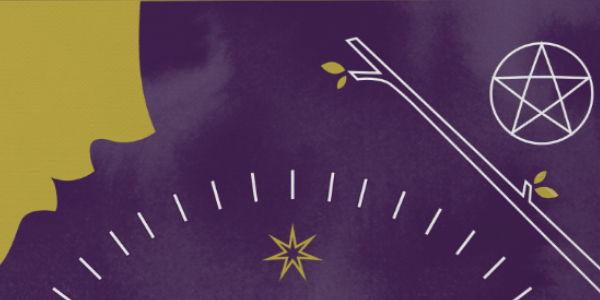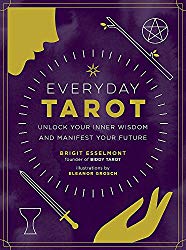
Everyday Tarot: Unlock Your Inner Wisdom and Manifest Your Future, by Brigit Esselmont
Running Press, 9780762492800, 216 pp., 2018
Everyday Tarot: Unlock your Inner Wisdom and Manifest your Future by Brigit Esselmont is a tarot workbook that goes beyond simply breaking down the meaning of each tarot card. I have followed Esselmont’s blog that posts articles, spreads, advice and even a podcast on her website, biddytarot.com), which she mentions throughout the book. I enjoy her website and this made me curious about what her book would offer.
Everyday Tarot focuses heavily on using your personal intuition to read your tarot cards and to make a one-on-one connection with yourself, the tarot, and your subconscious. Esselmont begins with a chapter that is a quick start guide with symbol charts. It goes over the meaning for the suits cup, sword, wand, and pentagram. The guide provides short one word connections to each. This is more helpful for someone who has already started using the cards and likes having that one word association with the symbol to reading the cards.
What is also nice is that Esselmont goes over the difference between a tarot deck and an oracle deck, which I see sometimes confusing for people just starting out and looking for their first tarot set to use. She even tries to break the old superstition that you must have your first tarot deck gifted to you. If you are gifted your first tarot, that is great, but you can go out and buy your own as well. Esselmont has her own tarot, which is sold separately, but she does not try to push for that to be the one that is needed. She gives a list of questions to ask when one is looking to buy a deck since there are so many in every theme under the sun these days.
Her big push through out the book is that reading tarot is not about sitting down and memorizing a bunch of symbol sets out of a guidebook and spitting it back out when doing a spread — it is about becoming comfortable with the deck and making a true connection. It’s perfectly fine to refer to a guidebook for assistance but she advises to not let the guidebook hinder you from finding deeper personal meaning in the cards.
Tarot will never to tell you what to do nor will the cards decide on your behalf, instead, Tarot offers information, possibilities and new insights.1
This is one of the big pitfalls people come across in first starting out with tarot: they turn it from a tool of guidance to one that determines each moment of one’s day and allow it to become a crutch to not deal with life. The tarot is a versatile tool that can do many things and can be a great help in aligning one’s path, as Esselmont shows through Everyday Tarot, but it’s important to use the tarot wisely. It’s ok to take a moment and see how things are moving with the help of tarot, but one has to remember they can still make their own decision.
Along with the quick guide, Esselmont starts you off on the simple one to three-card pulls to see how the cards work individually and how they can work together to make a whole story. Then as you progress through the book, the spreads become larger and more complex. She shows spreads for finding a more ideal career that aligns with your true self, for gaining self-love, and then a run of the mill love spread.
A favoruite exercise of mine from this book is Tarot for Self-discovery. This exercise asks you to do a single card pull each day and see how it connects to you or what you should focus on that day. The next part of the exercise gets more into making your own interpretation with the “free flow writing” exercise that has you pull a card and write for 15 minutes straight of what you see with the card and what come to mind. “Manifestation is not a one-off activity, but should instead be a regular practice or interaction,” she writes.2
Though I have been working with tarot cards for more than 10 years, I am still learning new insights into each card. This exercise lets me reassess how I view the cards with my own intuition, in comparison to what is said in many guidebooks. What would really fascinate me is to do this exercise again with the same cards six months, or even a year down the road, and see if my perception has changed. Whether you have worked with the cards for only a few months or more than 20 years, this would be a good exercise to sit with your favourite cards and see how your relationship has grown with this simple exercise.
At times though, Everyday Tarot lacks details about individual cards. I understand that is accessible on her website or with her own tarot cards she came out with recently, but a bit more information in this book would have been preferable. The descriptions used throughout Everyday Tarot are simplistic in design and colour. This would be a good book if you have just started reading tarot and need some more guidance and insight in working with the cards, but not necessarily as a complete beginner’s book to learn the meanings, unless you have something else to fall back on, such as Esselmont’s website.
Nevertheless, Everyday Tarot is a useful book to add to your collection. This books gives good exercises when it comes to everyday life and creating both short term and long term goals to utilize the tarot. Esselmont focuses heavily on the personal intuition, but also give practical insight to tarot use. She suggests to let the cards to be used as a tool, not as excuses or a way to avoid taking responsibility. “The key to using the Tarot in your decision making is taking ownership of your future and claiming your free will,” she writes.3 Esselmont shows that the tarot can be fun and useful in a our day to day life, which doesn’t make it any less mystical but more accessible to those who thought learning the tarot is too complicated. The only way to learn is to do and enjoy the ride.









